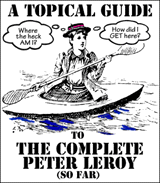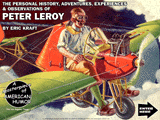
by Mark Dorset
Jorge Luis Borges:
One of the schools of Tlön has reached the point of denying time.
It reasons that the present is undefined, that the future has no other
reality than as present hope, that the past is no more than present memory.
Ernst Bloch:
Man is that which still has much before it. He is repeatedly
transformed in his work and by it. He repeatedly stands ahead on
frontiers which are no longer such because he perceives them, he ventures
beyond them. The authentic in man is outstanding, waiting, lives
in fear of being frustrated, lives in hope of succeeding. Because
what is possible can equally well turn into Nothing as into Being: the
Possible, as that which is not fully conditional, is that which is not
settled. Hence, from the outset, if man does not intervene, both
fear and hope are equally appropriate when confronted with this real suspension,
fear in hope, hope in fear. This is why the stoics—wise or all too
passively wise men—advised that man should not settle in the vicinity of
circumstances over which he has no power. But since in man active
capacity particularly belongs to possibility, the display of this activity
and bravery, as soon as and in so far as it takes place, tips the balance
in favor of hope.
Ralph Waldo Emerson:
He who aims at progress, should aim at an infinite, not at a special
benefit. . . .
The soul can be appeased not by a deed but by a tendency. It
is in a hope that she feels her wings. You shall love rectitude and
not the disuse of money or the avoidance of trade: an unimpeded mind, and
not a monkish diet; sympathy and usefulness, and not hoeing or coopering.
Tell me not how great your project is, the civil liberation of the world,
. . . the establishment of public education, cleaner diet, a new division
of labor and of land, laws of love for laws of property;—I say to you plainly
there is no end to which your practical faculty can aim, so sacred or so
large, that, if pursued for itself, will not at last become carrion and
an offence to the nostril. The imaginative faculty of the soul must
be fed with objects immense and eternal. Your end should be one inapprehensible
to the senses: then it will be a good always approached,—never touched;
always giving health.
Ernst Bloch:
Every dream remains one by virtue of the fact that too little has succeeded,
become finished for it. That is why it cannot forget what is missing,
why it holds the door open in all things. The door that is at least
half-open, when it appears to open onto pleasant objects, is marked hope.
Though, as we have seen, there is no hope without anxiety and no anxiety
without hope, they keep each other hovering in the balance, no matter how
far hope outweighs for the brave man, through the brave man. However,
hope too, which can deceive with will-o’-the-wisp, must be of a knowing
kind, one that is thought out in advance.
Marcel Proust:The specific remedy for an unfortunate event (and three events out of four are unfortunate) is a decision; for its effect is that, by a sudden reversal of our thoughts, it interrupts the flow of those that come from the past event and prolong its vibration, and breaks that flow with a contrary flow of contrary thoughts, come from without, from the future. But these new thoughts are most of all beneficial to us when (and this was the case with the thoughts that assailed me at this moment), from the heart of that future, it is a hope that they bring us.
See:
The Passionate Spectator: I suffer from a disease, a kind of
mental illness, the
groundless hope that springs eternal.
E-mail it to me, Mark Dorset.

 Here
are a couple of swell ideas from Eric Kraft's vivacious publicist, Candi
Lee Manning:
Here
are a couple of swell ideas from Eric Kraft's vivacious publicist, Candi
Lee Manning:
